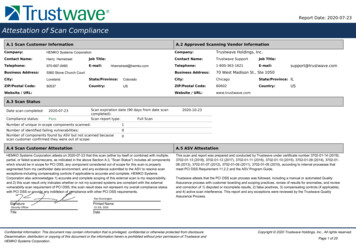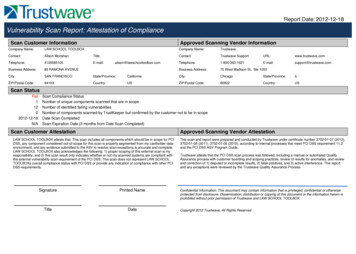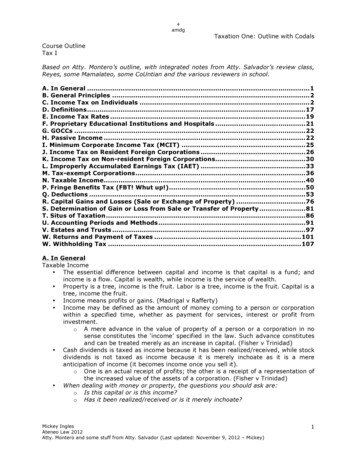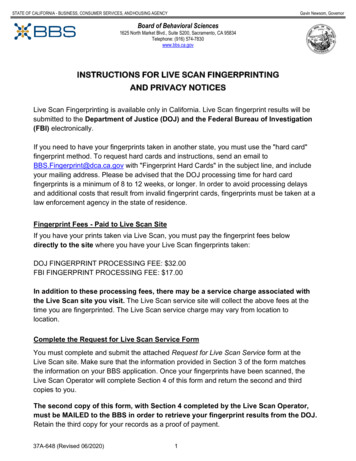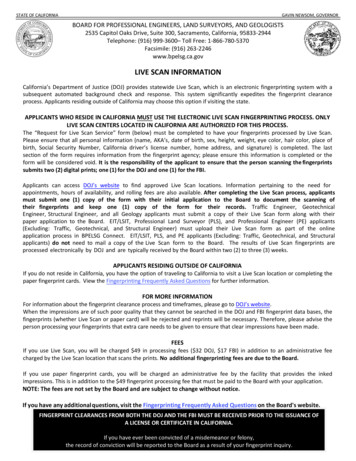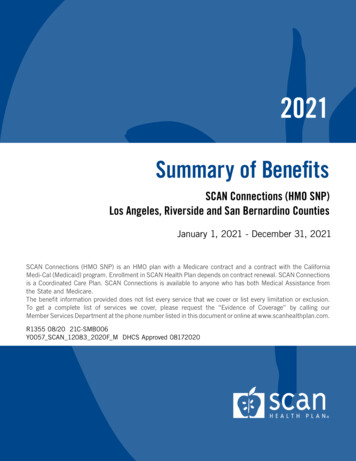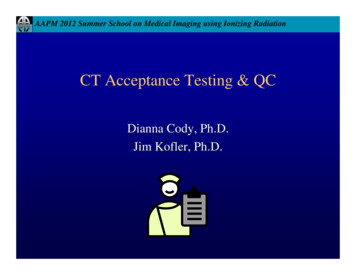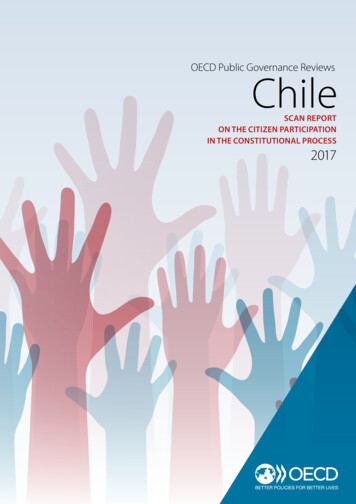
Transcription
OECD Public Governance ReviewsChileSCAN REPORTON THE CITIZEN PARTICIPATIONIN THE CONSTITUTIONAL PROCESS201735
What are Public Governance Scans?OECD Public Governance Scans are the abridged version of full-fledged PublicGovernance Reviews (PGRs) that provides governments with a 360 degreeperspective on their ability to deliver on government objectives. Rooted in thesound methodological approach of the PGRs, the Scans aim to deliver a diagnosisin a shorter period of time and in the format of a more concise output. Datacollection is based on OECD surveys and complemented with a fact-findingmission.This Scan specifically focuses on good governance performance in publicconsultation and citizen engagement within the framework of the constitutionalprocess open to citizens in Chile. The output focuses on:lkey actors and core processes;longoing reform initiatives;lobserved challenges.The Scan also offers preliminary indications on the good governance performancein public consultation and citizen engagement as compared to OECD standards.Why a Public Governance Scan on the citizen participationin the constitution-building process in Chile?The Chilean Government approached the OECD to carry out an assessment of theCitizen participation in the Constitution-Building Process in Chile (CPOC – ProcesoConstituyente Abierto a la Ciudadanía), identify lessons learned and advise on howto further improve citizen engagement in policy making processes.The primary objectives of this Public Governance Scan are to:llllassess the participative consultation process and its methodology in theconstitution-building process;analyse current open government and citizen participation practices designedand implemented in the country;identify areas of improvement, based on good practices by OECD members andpartner countries;provide examples from other countries on citizen participation in theconstitution-building process.This Public Governance Scan includes the following sections:llbSetting the Context for Constitution-building process;Public Participation in Chile: Challenges for the Participative Constitutionbuilding process;lCitizens at the Forefront of the Constitution-building Process;lFostering an Open and Inclusive State in Chile.
OECD Public Governance ReviewsChileSCAN2017Setting the context for a constitutionbuilding processChile is one of the most stable and prosperous countries in Latin America, with a significant index of political stability,economic growth and poverty reduction (World Bank, 2016). Even though the country still has some challengesahead, it joined the OECD in 2010, becoming the first South American country to join the Organisation.In parallel to its economic, political and social evolution, Chile has made important efforts over the past decades toimprove its citizens’ quality of life (OECD Better Life Index, 2016). It has modernised the State apparatus and reformed itspublic sector to provide better services to citizens (OECD, 2016a;2017).In this context, the Government of Chile has set in motion several initiatives to promote citizen participation. One initiativestands out for its nature and relevance: the constitution-building process, during which the Government designed andconducted a public consultation to promote a debate and collect information on how Chileans would like to shape theirconstitutional framework. The consultation mechanism proposed by President Michelle Bachelet lasted from April toAugust 2016. It addressed all citizens, and spanned the local, provincial and regional levels.CONSTITUTION-BUILDING PROCESS: INTERNATIONAL PRACTICES AND EXPERIENCESHistory has shown that constitution-drafting and citizen consultation do not follow a single model (United NationsDevelopment Programme [UNDP], 2015):lllllLegislative branch. When the Congress is the body in charge of drafting a new constitutional law, a specificcommission is generally created within the Parliament, comprising previously elected parliamentarians. When theCongress drafts a constitutional law, the entire Congress can be selected as a constitutional power or a smallercommission can be created, as happened in Greece (1975), Poland (1997) and Croatia (2000).Constituent Assembly. This is a body of citizens elected by universal suffrage for the sole purpose of discussingand designing a constitutional draft. An essential factor that guarantees the legitimacy of the constitution-draftingprocess is that the different groups and sectors co-existing in society are represented thanks to dedicated tools,such as electoral quotas and reserved seats. Italy (1947), Portugal (1979), Colombia (1991), Iceland (2010) and Tunisia(2014) are some of the most relevant cases.The Constituent Congress or Parliament comprises parliamentarians elected by popular vote to draft theconstitution and legislate. Spain (1978), Peru (1993) and South Africa (1996) are examples of this mechanism, whichis similar to the Constituent Assembly.Constituent Commission or Experts Committee. A group of experts, generally appointed by the government, is in charge ofdiscussing and drafting the constitutional text, as has happened in France (1958), Slovenia (1991) and Switzerland (1999).Finally, in some countries in post-conflict situations, such as Bosnia-Herzegovina (1995), the internationalcommunity has played a critical role in the constitution-making process through the Dayton Agreement.11. 0the%20State/Chapter12 Framing.pdf1
OECD PUBLIC GOVERNANCE SCAN – CHILEA growing trend in recent years has been to includeforms of direct citizen participation in these constitutionbuilding processes (UNDP, 2015). These initiatives (e.g.in Colombia, Ireland, Iceland and Tunisia) can vary intheir scope, level of participation, non-binding characterand final impact. They usually constitute the first stagein gathering ideas and reaching a consensus on thekey principles and topics to be included in the newconstitution. These participative processes are followedby a final referendum, which determines the ultimatenature of the new draft.Most common tools for a constitutional reforms(1945-2012), Number of stituentCongressSource: UNDP (2015)AMENDING THE CONSTITUTION: A HISTORICALLY ARDUOUS DEBATEThe current Chilean Constitution has been in place since 1980, pushed through by the regime of the former dictatorAugusto Pinochet. Although Chile returned to democratic governance over 25 years ago, a strong polarisation of politicalopinions and public policy approaches still prevails,2 particularly with regard to the constitution-building process: the callfor a new constitution is perceived as emanating from the left-wing political parties, whereas a vast majority of the rightwing rejects the idea. In fact, the elaboration of a new constitution has been a long-standing demand since the end ofthe Pinochet regime, as the current Chilean Constitution was approved during a state of siege characterised by politicalrepression. The right wing considers that the democratic transition already took place in 1990, and that the currentConstitution – which has been amended on many occasions –– can already be considered as new and free from anyconnotation of dictatorship. The left wing, on the other hand, is asking for a new Constitution born in democracy. Part ofthis left-wing group asks the new Constitution to be drafted by a Constituent Assembly.3Chapter XV of the current Chilean Constitution only enshrines the idea of partial constitutional amendment; it does notallow the drafting of a new constitution. However President Bachelet did include this possibility in the amended ChapterXV in April 2017. If this amendment is not approved, a new constitution would not be approved.4Since the return to democracy in 1990, the Chilean Constitution has been partially amended 39 times to legitimise andadapt it to the needs of the State; however, no new constitutional text has been adopted. In 2005, former PresidentRicardo Lagos undertook one of the most important amendments to relevant chapters of the Constitution. Among otherissues, these amendments curbed military power, and reduced authoritarian enclaves by abolishing appointed and lifesenatorships, limiting the power of the State Security Council and strengthening democratic institutions.Despite these important changes, the demand for a new “democratic constitution” has persisted. In the 2013 presidentialcampaign, President Bachelet, supported by a number of political parties and citizens, stressed the lack of legitimacy ofthe current Chilean Constitution and the need for an entirely new fundamental law, achieved through an “institutional,democratic, and participative” process providing social legitimacy to the Chilean political system, instilling renewedconfidence in citizens and addressing inequalities.5After taking office in March 2014, President Bachelet launched a complex constitutional-reform process in October 2015–the first of its kind in Chile – to engage citizens in early-stage dialogue, with the aim of submitting a new draft constitutionto the Congress before the upcoming November 2017 general elections.2. http://www.sgi-network.org/2016/Chile/Executive Summary.3. http://www.bbc.com/mundo/noticias/2015/04/150429 chile constitucion 80 bachelet irm.4. Articles 5 and 15 describe the different modalities for plebiscites on constitutional reforms and local plebiscites.5. As stated in President Bachelet’s speech of 13 October 2015: uyente/.2
Public Participation in Chile:Challenges for the ParticipativeConstitution-building ProcessThe following section describes the context for public participation and consultation on constitutional issues,focusing on Chile, a country with a low tradition of citizen engagement, to explain the rationale for a participative,grassroots process.PUBLIC PARTICIPATION AS AN ENABLER OF A DEMOCRATIC AND OPEN GOVERNMENTInitiating a constitution-building process through a participative process raises the issue of democracy and its differentdimensions. Democracy can be exercised in different ways. Representative democracy is a governance system in whichall eligible citizens elect representatives at the presidential, legislative and subnational levels to take decisions and passlaws, each according to their respective competencies. In Chile, as in a vast majority of countries, it is the most commongovernance system, rewarding traditional representation through elections. Chile also functions under a so-called directdemocracy, where the President can pose specific questions in determined cases to the public through direct consultationmechanisms (e.g. referendums and/or plebiscites), as stated in Article 5 of the Chilean Constitution. Participative democracyis one of the most recent dimensions of democracy; it incorporates additional consultation mechanisms and interactionwith citizens in the public policy-making process. Finally, social movements are another essential element influencing thedemocratic regime, leading to changing the meaning of objectives of a particular government policy’s objectives.Lately, an effort has been made to emphasise and highlight the complementarities between the different dimensions. TheEuropean Union’s Lisbon Treaty6 enshrines the complementarity between representative democracy and participativedemocracy. The Treaty also confers upon citizens “the right to participate in the democratic life of the Union” and stipulatesthat “decisions shall be taken as openly and as closely as possible to the citizen”.7Dimensions of democracy and citizen participation Most recognised citizen practice New institutionalisation processes Elections of authorities More developed at the local level Higher institutionalisation Not deeply rooted in political culture Political parties Linked to referendums andplebiscites Influence of public policy cycle Building consensus Different modalities (consultationsand political technical support forpublic hearings Requires strengthening obilisation Social protests and movements Class actions Associative rce: Author’s own elaboration, based on Sol Arriaza, R. (2012), El Desafío de la Participación Ciudadana en el Estado Democrático de Derecho, FLACSO, Costa Rica.6. Articles 10 and 117. Article 10.3. For further information, please consult: nts-giii 17mar2011.pdf3
OECD PUBLIC GOVERNANCE SCAN – CHILEInternational declarations also recognise the importance of citizens and civil society in policy making (OECD, 2016a):llllAgenda 21, the outcome statement of the United Nations Conference on Environment and Development (the “EarthSummit”), which was held in 1992 and brought together 172 governments, recognised that “one of the fundamentalprerequisites for the achievement of sustainable development is broad public participation in decision-making”(United Nations, 1992; United Nations Economic Commission for Europe, 1998).The Arhus Convention on Access to Information, Public Participation in Decision-Making and Access to Justicein Environmental Matters, ratified in 1998 by 40 countries, recognised the importance of public participation inenvironmental governance and established the public’s rights to be involved in national governance.8The Future We Want, the outcome statement of the 2012 Rio 20 Conference, which convened 192 governmentsand helped lay the groundwork for the Sustainable Development Goals, states: “We underscore that broad publicparticipation and access to information and judicial and administrative proceedings are essential to the promotion ofsustainable development. [.] In this regard, we agree to work more closely with Major Groups and other stakeholdersand encourage their active participation, as appropriate, in processes that contribute to decision making, planningand implementation of policies and programmes for sustainable development at all levels” (United Nations, 2012).The OECD considers public participation “as the interaction, either formal or informal, between government andcitizens (e.g. civil-society organisations [CSOs], academia and the private sector) at the initiative of either, that isused to inform a specific policy outcome in a manner that ensures well-informed decision making and avoids policycapture “(OECD, 2016 background paper).The 2008 financial crisis highlighted the need for countries to restore citizens’ trust, as well as strengthen their democraticsystem through more proactively engaged and informed citizens. While governments can “no longer afford to provide incompleteinformation or just ask the public its opinions on matters that are fait accompli” (Caddy, 2011), citizens are demanding a moreproactive role where they become not only beneficiaries, but also key partners in policy making. Thus, citizen engagement isconsidered a condition for effective governance (OECD, 2009), as well as a core element of open government.The OECD defines open government as “a citizen-centredculture of governance that utilizes innovative and sustainabletools, policies and practices to promote governmenttransparency, responsiveness and accountability to fosterstakeholders’ participation in support of democracy andinclusive growth” (OECD, 2017).9 The experience of OECDcountries, moreover, shows that access to information andtransparency, along with public consultation and initiativesto promote active and conscious citizen participation inpolicy making, contribute to good governance by improvingthe quality of policies and services, and ensuring higherlevels of implementation and compliance (OECD, 2016b).The OECD has untangled the different participation andengagement levels of open government, allowing countriesto better understand innovative practices in their countriesand beyond.Participation as a core principle of open ource: Author’s own elaboration.8. Convention on Access to Information, Public Participation in Decision-Making and Access to Justice in Environmental Matters, Aarhus, Denmark, 25 June, e.pdf (accessed 15 June 2017).9. The OECD is currently undertaking a public consultation on the OECD draft Recommendation of the Council on Open Government, which entails the definition. Formore information, please seehttp://www.oecd.org/gov/open-government.htm4
PUBLIC PARTICIPATION IN CHILEIn the same vein, public participation varies, from its weakest form (the basic provision of information by the government)to its fullest (co-production, co-delivery and co-evaluation, involving a balanced share of powers among stakeholders),each with different objectives and expected impacts (OECD, 2016b).The imaginary ladder of participation practices: Levels of stakeholder participationINFORMATIONCONSULTATIONENGAGEMENT Make information and data available to other parties Make targeted audience more knowledgeable and sensitive to specific issues Encourage stakeholders to relate to the issue and take action Gather comments, perception, information and experience of stakeholders No obligation to take stakeholders’ view into consideration in final outcome Provide opportunities to take part in the policy processes May entail that participants have an influence over decision making Can include elements of co-design/co-production; balanced share of power amongstakeholders involvedSource: adapted from OECD (2015a), “Policy Shaping and Policy Making: The Governance of Inclusive Growth”, OECD Publishing, Paris.LESSONS LEARNED: INTERNATIONAL EXPERIENCE1. Enhancing citizen participation. Citizens can be involved at different stages of policy making, transitioning “from apartnership between citizens and governments to ‘co-production/co-creation’” (OECD, 2016b). Citizens and civil societycan have different roles (World Economic Forum, 2013), including acting as watchdogs or campaigners for societalissues, promoting fundamental values, advocating for minority groups and contributing to concrete policies throughparticipative budgeting. This can help build a more participative democracy, where citizens interact with publicauthorities and contribute new inputs to a given initiative.2. Managing citizen expectations. The 2008 financial crisis led OECD countries to adopt more interactive policies torestore citizens’ trust in government. Because Chileans generally distrust politics, public life and government, theChilean Government need to manage and answer their expectations during participative processes (especially on sucha sensitive topic such as the constitution-building process), while also following through on its own commitments.OECD research underlines the importance of providing a clear process, timelines and advance notice, as well as raisingawareness to strengthen citizen involvement and move towards a more open, transparent, accountable and participativegovernment (OECD, 2016b). Thus, interaction between citizens and government, through continued dialogue and anopen government practice, is essential to promoting trust in any national policy.3. Involving the legislative and the judiciary branch. Such involvement can foster an open state and help to achievenational objectives built on a national consensus. For example, Costa Rica has committed to creating an open stateby involving the executive branch, the Legislative Assembly, the judicial branch and the Supreme Electoral Court innational initiatives fostering transparency, promoting citizen participation and combating corruption.5
OECD PUBLIC GOVERNANCE SCAN – CHILEPUBLIC PARTICIPATION IN CHILE: A WORK IN PROGRESSA country with low public participation and citizen engagement According to the main international organisations and key national stakeholders, Chile is one of the region’s mostconsolidated and stables democracies, while paradoxically facing a deficit in participative governance. As shown in theinterviews conducted during the fact-finding mission, this conundrum stems partly from the unresolved legacy of thetransition to democracy, and the disconnection between citizens and public authorities.10 The low trust levels, togetherwith a weak sense of community and a decreasing rate of voter registration and turnout, also illustrate this reality (OECD,forthcoming).Only 49% of all registered voters in Chile voted during the most recent general elections (2013) for which data areavailable; this is one of the lowest voting rates in OECD countries, where average turnout is 68% (OECD Better LifeIndex, 2016). Recognising the problem of low political involvement and participation, the legal framework surroundingelectoral participation had already transitioned in 2012 from free registration with compulsory participation to automaticregistration with free participation to engage more citizens in elections and combat abstention. However, the new systemfailed to achieve higher voting participation, at least in the last municipal elections (October 2016), which registered thelowest electoral turnout (34.9 %) since the country’s return to democracy. This low participation could also be related tofrequent corruption scandals, as well as voter disenchantment and apathy, seemingly the country’s greatest challenges.11Confidence in national government in 2014 and confidence change since 2007Percentage points% in 2014 (right axis)Percentage points change since 2007 (left NGRCPRTESPFINSVN-20Source: OECD (2015b), Government at a Glance 2015, OECD, Paris, http://dx.doi.org/10.1787/gov glance-2015-enAs stated, Chileans seem to have low confidence in public authorities and the Government. According to a bi-monthlysurvey last conducted by the Centre for Public Studies (Centro de Estudios Públicos) in May 2017, only 11% of citizens believethat democracy works or works well in Chile (compared with 26% in October 2010).12 Thus, the level of political participation– either formal (i.e. through running or voting in elections) or informal (e.g. through political activism and interest inpublic affairs) – remains relatively low: less than 5% of citizens are members of a political movement or party, businessassociation, co-operative, foundation, charity association, professional association, academic association, cultural groupor volunteer association.13 Likewise, more than 50% of survey respondents do not follow political news or speak aboutpolitics with family or friends. In fact, according to the 2013 Human Development Report (UNDP, 2013), Chile is among the10. idencias-N6.pdf.11. . 0170601155007/encuestacep abr may2017.pdf.13. Report by the National Council of Citizen Participation.6
PUBLIC PARTICIPATION IN CHILELevels of citizens participation in Latin Americaand the CaribbeanWell-being indicators for ChileSUBJECTIVEWELL-BEINGCountries with the highest levels of citizen participationHaiti91.8%Bolivia84.9%Dominican CIVICENGAGEMENTANDGOVERNANCECountries with the lowest levels of citizen azil43.4%Costa RicaFeelingsafe atnightHomicidesLifesatis factionINCOME ANDWEALTHFinancialwealth EmploymentLabour marketinsecurityStakeholderengagementRooms TIONAND SKILLSSources: OECD (2016d), Open Government Review of Costa Rica; OECD Publishing, K-LIFEBALANCEWorkinghoursSocialsupport41%JOBS ANDEARNINGSYears ved healthLife USBBC Mundo, “El país con menos participación ciudadana de América Latina” ,http://www.bbc.com/mundo/noticias/2013/10/131025 america latina costa rica politica(accessed 27 June 2017).Source: OECD Better Life Index, 2016 www.oecdbetterlifeindex.org/countries/chile/.five countries in Latin America registering the lowest percentage of citizen participation in CSOs. At the same time, the2015 UNDP report explains how “the politicization process of Chilean society is full of contradictions and indecisions, oftensions and difficulties, of moments in which it rears up with force and others when its development gets stuck”. Indeed,a wide demand exists among different segments of the population for profound changes, particularly regarding key publicservices such as health (79%) and education (77%).14The low level of citizen engagement in electoral- or regulatory processes, which scored 1.3 in the OECD Better Life Index,decreases the legitimacy of the democratic system, and in particular of the government, which is accountable to its electorateand citizens.The results are similar in the area of regulatory policy, which also has an impact on citizens’ lives. In Chile, the level ofstakeholder engagement in developing regulations is 1.5 (on a scale between 0 and 4) – lower than the 2.4 OECD average (OECD,Better Life Index 2016). Chile lags behind most OECD countries in ensuring that the public can systematically participate inthe regulatory process, where effective consultation is crucial to ensuring that citizens’ and businesses’ interests are takeninto account when developing and designing regulation.10090Voter turnoutStakeholder engagement for developing regulations3.580370Voter akeholder engagement for developing regulationsCivic engagement in ChileSource: OECD Better Life Index 2016, www.oecdbetterlifeindex.org/countries/chile/.14. iempos-de-la-politizacion/7
OECD PUBLIC GOVERNANCE SCAN – CHILE. But a sound legal framework governing public participationIn January 2017, the National Council of Citizen Participation (Consejo Nacional de Participación Ciudadana) convened by PresidentBachelet published a report on the current situation, past achievements and remaining challenges for citizen participation inChile. The report summarises the context in which citizens are given the opportunity to express their opinions, acknowledgingthat complex and institutionalised procedures at the central level have “neither led to a redistribution of power to society,nor to the construction of a true political community, nor did they establish channels or mechanisms for ongoing and activecitizen participation in the national and public administration discussions” (National Council of Citizen Participation, 2017).As explained in the previous section, the Chilean Constitution’s only provision regarding citizen participation relates tothe possibility of holding a plebiscite in the event of constitutional reform, or consultations at the municipal level. Thedeficit in public participation does not stem from a lack of laws, mechanisms or guidelines. Since 2008, the Government ofChile has made significant efforts to regulate and promote participation, notably through Law No. 20 50015, establishingspecific rules for citizen participation in public policy, as well as the 2008 Presidential Instructive Note No.00816 and the2014 Presidential Instructive Note No. 007/201417 on Associations and Public Participation in Public Management.18Legislation and strategic plans defining Chile’s open government agenda2008 Law on Access to PublicInformation n. 20.2852006 Presidential Instruction onActive Transparency2012 Presidential Instruction onDigitalisation of Public Procedures2011 Law on Associations andCitizen Participation inPublic Management n. 20.500ACCESS TOINFORMATIONCITIZENPARTICIPATION2012 Law of Automatic registrationand voluntary vote n. 20.568STRATEGIESAND PLANS2011 Presidential Instruction for CitizenParticipation n. 02/2011Agenda Digital 2020E-participation: New technologiesfor the Citizens’ Service3rd Open Government Partnership’sAction Plan 2016–2018Citizen Participation as a PublicPolicy: Chile fulfillsSource: Government of Chile (n.d.), Gobierno Abierto – Documentos, http://www.gobiernoabierto.gob.cl/documentos (accessed 15 June 2017); OECD (2016c), Digital Government in Chile:Strengthening the Institutional and Governance Framework, OECD Publishing, Paris, http://dx.doi.org/10.1787/9789264258013-enLaw No. 20 500 and the Presidential Instructive Note No. 007/2014 identify ways in which the central governmentcan foster greater participation (including by the public) as well as participative budgeting, consultations (especiallythrough sectoral commissions on key topics such as health, education and housing) and other mechanisms (e.g. digitalparticipation platforms). These initiatives are mainly co-ordinated by the Ministry General Secretariat of Government(Ministerio Secretaría General de Gobierno [SEGEGOB]), while the open government agenda is led by the Ministry GeneralSecretariat of the Presidency (Secretaría General de la Presidencia [SEGPRES]). At the local level, municipalities must alsoestablish a municipal Council of Civil Society Organisations (Consejo Comunal de Organizaciones de la Sociedad Civil [COSOC])as an advisory body on local planning. These initiatives have not always generated the expected results (Carvallo, 2015).For instance, only 63% of municipalities have created a COSOC. Interviews also showed that the Government is awarethere is still room for improvement.15. National Congress Library of Ch
XV in April 2017. If this amendment is not approved, a new constitution would not be approved.4 . l Agenda 21, the outcome statement of the United Nations Conference on Environment and Development (the “Earth Summit”), which was held in 1992 and brought together 172
